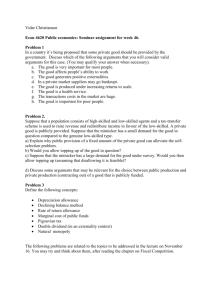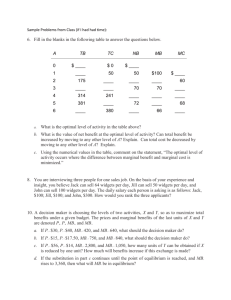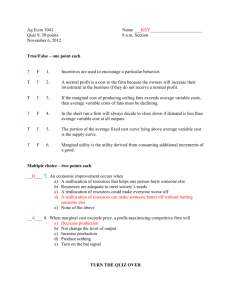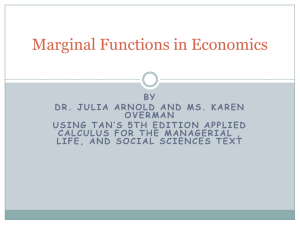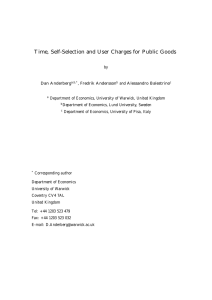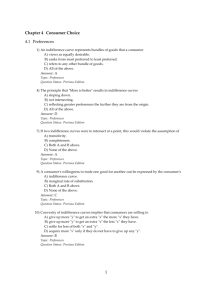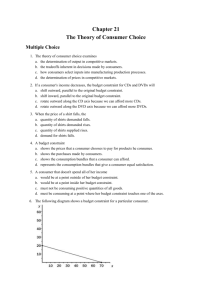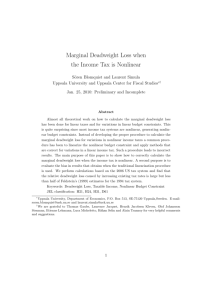The issue is covered in the curriculum by Christiansen`s IIPF lecture
advertisement
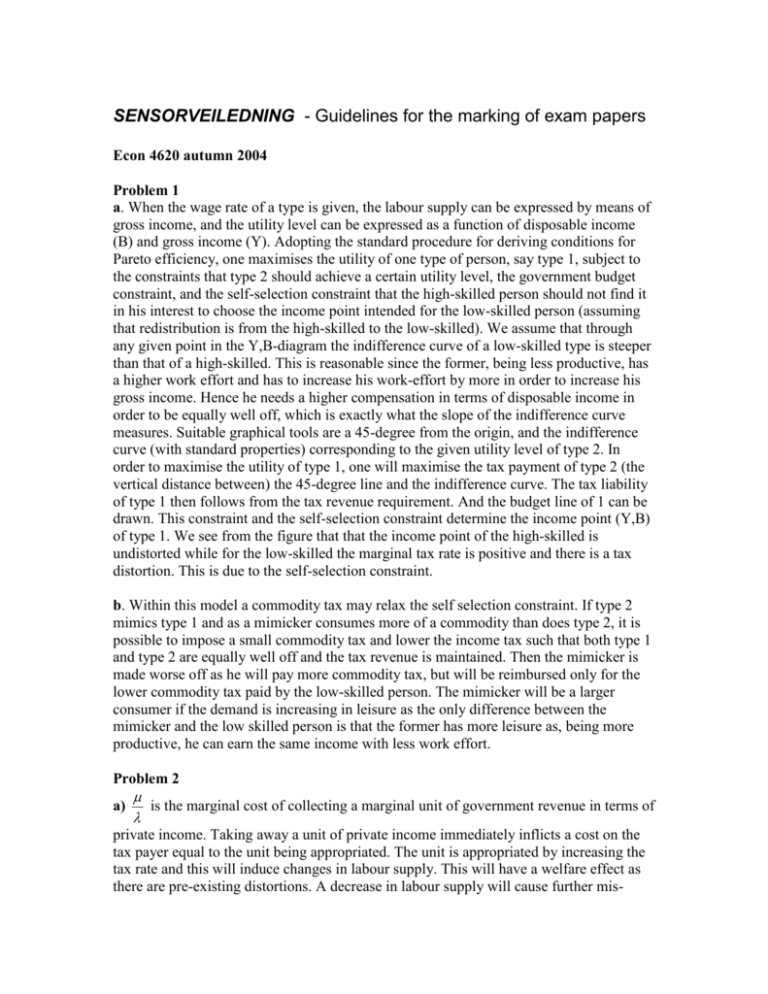
SENSORVEILEDNING - Guidelines for the marking of exam papers Econ 4620 autumn 2004 Problem 1 a. When the wage rate of a type is given, the labour supply can be expressed by means of gross income, and the utility level can be expressed as a function of disposable income (B) and gross income (Y). Adopting the standard procedure for deriving conditions for Pareto efficiency, one maximises the utility of one type of person, say type 1, subject to the constraints that type 2 should achieve a certain utility level, the government budget constraint, and the self-selection constraint that the high-skilled person should not find it in his interest to choose the income point intended for the low-skilled person (assuming that redistribution is from the high-skilled to the low-skilled). We assume that through any given point in the Y,B-diagram the indifference curve of a low-skilled type is steeper than that of a high-skilled. This is reasonable since the former, being less productive, has a higher work effort and has to increase his work-effort by more in order to increase his gross income. Hence he needs a higher compensation in terms of disposable income in order to be equally well off, which is exactly what the slope of the indifference curve measures. Suitable graphical tools are a 45-degree from the origin, and the indifference curve (with standard properties) corresponding to the given utility level of type 2. In order to maximise the utility of type 1, one will maximise the tax payment of type 2 (the vertical distance between) the 45-degree line and the indifference curve. The tax liability of type 1 then follows from the tax revenue requirement. And the budget line of 1 can be drawn. This constraint and the self-selection constraint determine the income point (Y,B) of type 1. We see from the figure that that the income point of the high-skilled is undistorted while for the low-skilled the marginal tax rate is positive and there is a tax distortion. This is due to the self-selection constraint. b. Within this model a commodity tax may relax the self selection constraint. If type 2 mimics type 1 and as a mimicker consumes more of a commodity than does type 2, it is possible to impose a small commodity tax and lower the income tax such that both type 1 and type 2 are equally well off and the tax revenue is maintained. Then the mimicker is made worse off as he will pay more commodity tax, but will be reimbursed only for the lower commodity tax paid by the low-skilled person. The mimicker will be a larger consumer if the demand is increasing in leisure as the only difference between the mimicker and the low skilled person is that the former has more leisure as, being more productive, he can earn the same income with less work effort. Problem 2 a) is the marginal cost of collecting a marginal unit of government revenue in terms of private income. Taking away a unit of private income immediately inflicts a cost on the tax payer equal to the unit being appropriated. The unit is appropriated by increasing the tax rate and this will induce changes in labour supply. This will have a welfare effect as there are pre-existing distortions. A decrease in labour supply will cause further mis- allocation as the labour is already under-supplied. There is a tax wedge implying that the marginal opportunity cost of leisure (equal to the gross wage rate) exceeds the marginal willingness to pay for leisure (equal to the after-tax wage rate). The social cost of additional leisure then exceeds the benefit, and this is an extra cost (the excess burden) of appropriating a marginal unit of income. It is obviously larger the larger is the tax (t) and the stronger is the labour supply response ( ). is called the marginal cost of public funds. It captures both the effects described above and hence it is larger than unity for t>0 and >0, and increases in t and for the reasons just discussed. b. To increase the supply of the public good by one unit requires that p units of income are appropriated from the private sector. The total social cost is then p when also the excess burden is taken into account. This cost should be equated to the aggregate marginal social benefit, as measured by the sum of marginal willingness to pay. This is the economic content of (4). c. A weakness of the model is that it captures tax distortions without capturing the reasons why taxes are distortionary. In the model all people are equal, and it is just assumed that only a distortionary tax is available. There is no heterogeneity and no asymmetric information explaining why distortionary taxes are needed. (Cf. problem 1). Introducing public goods into the Mirrlees model yields an entirely different result. Problem 3 The issue is covered in the curriculum by Christiansen’s IIPF lecture and the article of Besley and Gouveia. Central arguments that can be developed are a) insurance problems in the health sector due to pre-existing conditions, b) inadequate funding of education in the market, c) public provision that relaxes the self-selection constraint in a non-linear income tax regime, d) saving of transactions costs, e) certain externalities (but usually taxes or subsidies should be used to correct for externalities.) At least some of these arguments should be addressed.

